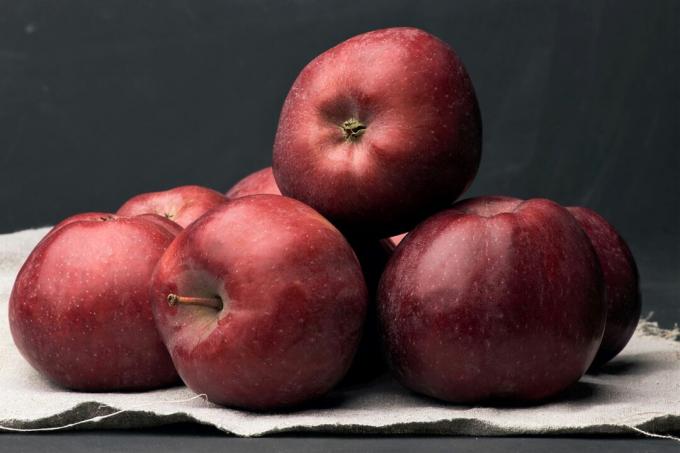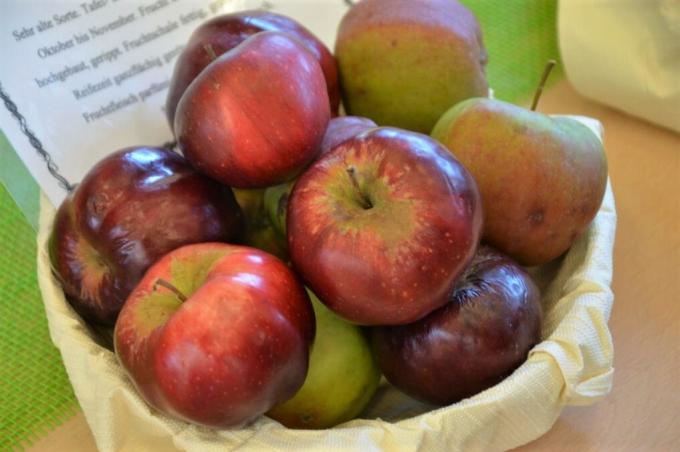The ‘Roter Herbstkalvill‘ apple lives up to its name: It is characterized by its bright red fruits. What else makes the apple variety special and how to get it ‘Red autumn calvilla‘ grown in the garden, we reveal here.

The ‘Rote Herbstkalvill‘ is considered a pomological specialty and also a diva. The variety also known as ‘pomegranate‘, ‘large red summer raspberry apple‘, ‘raspberry apple‘, ‘red autumn calvilli,‘ strawberry apple ‘or‘ gypsy apple ‘has high demands on its location. It requires a lot of maintenance in less than perfect locations. The apple variety rewards every devoted lover with an unmistakable strawberry and raspberry aroma, wrapped in a unique red fruit.
contents
- ‘Rote Herbstkalvill‘: Wanted poster
- Origin and history of the apple
- Taste and characteristics of the ‘Red Herbstkalvill‘
- Special features in cultivation
- Harvest time and use of the apple variety ‘Roter Herbstkalvill‘
‘Rote Herbstkalvill‘: Wanted poster
| Synonyms | ‘Pomegranate‘, ‘Large Red Summer Raspberry Apple‘, ‘Raspberry Apple‘, ‘Red Autumn Calvill‘, ‘Strawberry Apple‘, ‘Gypsy Apple‘ |
| fruit | medium-sized; dark red body color |
| taste | balanced sweet and sour; Strawberry and raspberry aromas when fully ripe |
| Yield | not very high; regularly |
| Harvest time | from the end of September |
| Ripe for enjoyment | Late September to November |
| Shelf life | bad; storable until Christmas |
| growth | strong |
| climate | warm and sheltered location |
| Diseases and pests | susceptible to apple scab, powdery mildew, fruit tree canker and fruit rot in unsuitable locations |
Origin and history of the apple
The ‘Rote Herbstkalvill‘ is a veteran: it was allegedly mentioned as early as 1565 as part of the princely pleasure garden in Stuttgart. However, this story is not entirely certain. A certain André Leroy claims in a historical document that the ‘Rote Herbstkalvill‘ was found in the French Auvergne and was only mentioned in 1617. In Central Europe, it was once grown very often, but now it is hardly ever to be found.
Incidentally, the name ‘Edelkönig‘ is not a synonym, but a variety, i.e. a variety that differs slightly from the ‘Rote Herbstkalvill‘. It is more egg-shaped and less irregular in shape than the original variety.

Taste and characteristics of the ‘Red Herbstkalvill‘
The ‘Rote Herbstkalvill‘ can be small, medium or rarely large - the latter is the case when the tree bears only a few fruits. The shape is broadly frustoconical or flattened and spherical and rather irregular with strong ribs. The cross-section is almost angular. The peel of the fruits is smooth and very shiny and greasy with a greenish-yellow base color, which is seldom seen. It is covered almost everywhere by a dark, almost red-black covering color. The lenticels are easily recognizable as fine white rust spots. The flesh is white, but directly under the skin and in strips that pull inwards, it is marbled with a strong red color. If you bite into it, you will notice that it is fine-celled and fluffy and very juicy. The taste is sweet-sour and balanced, with a raspberry or strawberry-like perfume when fully ripe.
By the way: Because the core house is often designed very large in relation to the cores, it can happen with some specimens that the cores come off and so-called "rattle apples" arise. The pips can be heard rattling in the housing when you shake the fruit.
Special features in cultivation
The ‘Rote Herbstkalvill‘ has high demands on its growing climate and on the soil. It needs a lot of warmth, a sheltered location like in a good fruit growing area, as well as fertile and deep, moderately moist soil. If he does not find these conditions, he acknowledges this with susceptibility to diseases, in particular scab, powdery mildew, Fruit tree cancer and fruit rot. Premature fruit fall and low yields are also common in unsuitable locations.
However, if it feels comfortable in its place of growth, the following properties can be fully exploited: When young, the ‘Rote Herbstkalvill‘l has a strong growth and becomes tall and broad-crowned. The leaf is large and healthy. Because of the strong growth, the culture is suitable as a half or high trunk, but not forming in a trellis or as a bush tree. If you do not try to force the apple tree into an unsuitable shape, you will hardly have any costly pruning measures ahead of you after your upbringing.

Flowering is early to medium early and can be prone to frosts. Alternation - i.e. annual fluctuating yields - occurs in the ‘Rote Herbstkalvill‘, but under good conditions the yields are regular, if not very high.
Suitable pollinators are the varieties ‘Landsberger Renette‘,‘ Schmidberger Renette ‘,‘ White clear apple ‘and‘ Red maiden apple ‘.
Harvest time and use of the apple variety ‘Roter Herbstkalvill‘
Harvest time for the ‘Rote Herbstkalvill‘ is already at the end of September in order to receive stored apples. In order to enjoy the fruits directly, they should only be harvested between the end of September and November. The shelf life is poor, in a cool and slightly damp earth cellar the fruit only stays tasty until Christmas. Overripe red Herbstkalvill apples become floury.
This particular variety is suitable as an extravagant table apple. It can be preserved by pressing apple juice, which is light red in color. The variety is also very suitable for drying, the dried apple slices are pink. The ‘Rote Herbstkalvill‘ is not well suited for baking because of its loose pulp.
The forest-prone flowering of the ‘Red Autumn Calvary‘ can become a problem. Everything about flower frost and its effects, read everything about the special features of the Apple blossom.



